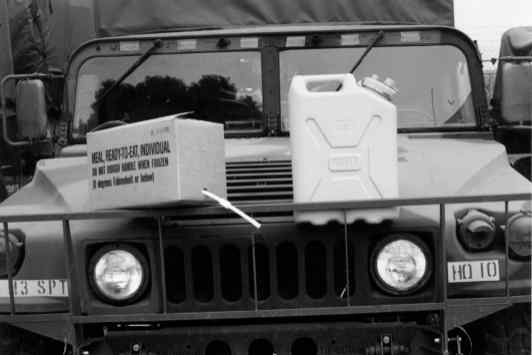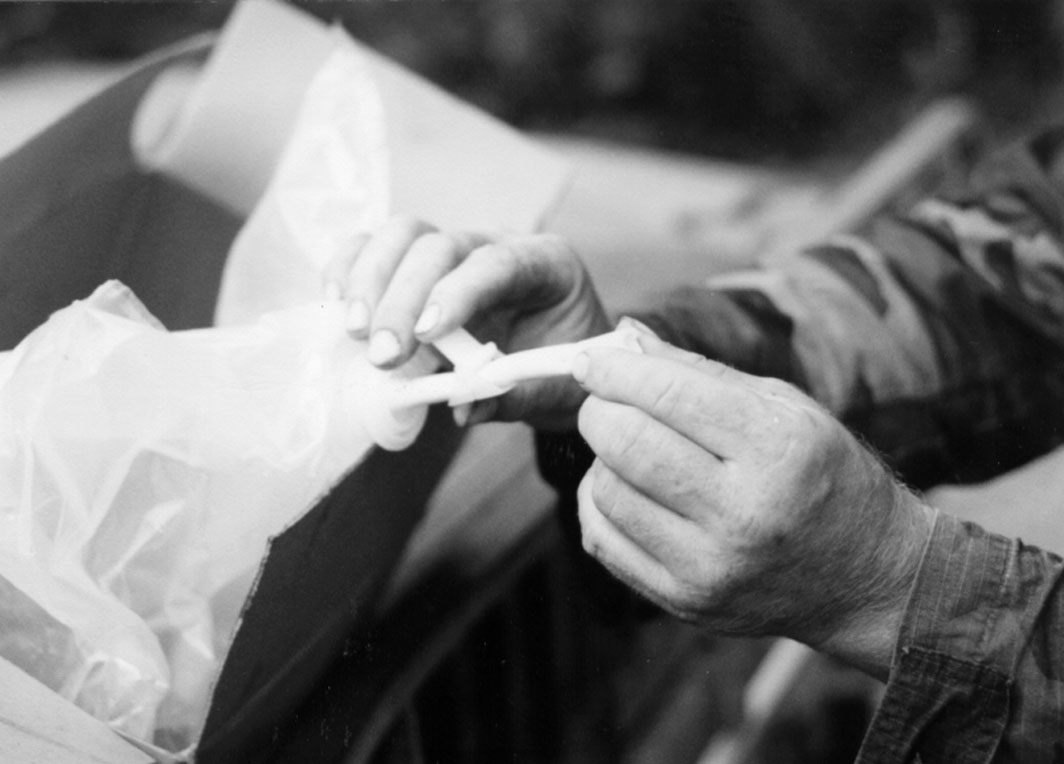 |
Water bags packed in MRE boxes are more stable in a moving vehicle than 5-gallon cans with their high center of gravity. |
by Major Robert O. Bosworth
Recent developments in the water-packaging arena have created alternatives to the 5-gallon water can as the method of choice for water resupply at the unit level.
The Army Forces Command (FORSCOM) has been using a water-packaging system that produces 1-liter bags of water that are small enough to fit into the cargo pocket of the battledress uniform (BDU). Several active-duty and Army National Guard light infantry units have been testing 6-gallon water bags developed by local contractors. The 1-liter and 6-gallon bags already have been used successfully at the Joint Readiness Training Center (JRTC), Fort Polk, Louisiana, and soldiers in the field have given them their stamp of approval. To logisticians, the ultimate benefit of these water bags is the flexibility they provide for supporting soldiers in the field.
An Ageless Challenge
Distribution of water from the brigade support area (BSA) to the individual soldier always has been a challenge. The process starts in the field trains and extends forward to the company combat trains. Unit supply personnel traditionally maintain a large inventory of 5-gallon water cans to provide continuous water support to soldiers. If 200 cans are required for a logistics package (LOGPAC) to resupply one infantry battalion in the field, a minimum of 400 cans must be maintained on hand, because another 200 cans must remain in the field trains for the next LOGPAC. The effort expended to collect the empty water cans and refill them in time for the next LOGPAC has been a constant headache for logisticians.
In an effort to improve logistics support to soldiers, FORSCOM purchased three vertical form, fill, and seal machines from the General Packaging and Equipment Company in Houston, Texas. These water-packaging systems were built to military specifications and can produce 30,000 1-liter bags of water a day at a cost of 30 cents per bag. The filled bags are distributed to units in cardboard boxes that hold 16 bags each. According to the FORSCOM project officer for the water-packaging system, the systems have been used with great success to support military operations and exercises at different locations around the world, including Egypt, Hungary, and Thailand.
The water-packaging system also was used at JRTC in support of the 41st Separate Infantry Brigade's (SIB's) rotation in June 1998. The 41st SIB's S4 reported that the water-packaging system gave logisticians at JRTC a degree of flexibility they had not had before. The 1-liter and 6-gallon water bags bridged the water resupply gap between LOGPAC's and company combat trains. Supply personnel were freed from the burden of tracking 5-gallon water cans distributed among various units, and combat trains had two quick and efficient options for providing water to individual soldiers. The bags also were ideal for units that pre-positioned or cached water in the field.
In addition to providing alternative water resupply methods for LOGPAC's, the water bags were especially effective for treating heat casualties at battalion aid stations in the 41st SIB's BSA at JRTC. Chilled 1-liter water bags provided relief to heat casualties and to soldiers in casualty evacuation situations and mass casualty exercises. Frozen 1-liter water bags were crushed to break up the ice inside and create an ice pack that conformed to the contours of bruised and injured limbs.
 |
Water bags packed in MRE boxes are more stable in a moving vehicle than 5-gallon cans with their high center of gravity. |
Kicking the Can
While FORSCOM has been refining the individual 1-liter bag, several light infantry units have examined the 6-gallon water bag as another practical alternative to the 5-gallon can. Captain William M. Connor, Jr., has written an article about the success of the 2d Battalion, 27th Infantry, in using 6-gallon water bags during its JRTC rotation. See his article, "Water Resupply in the Light Infantry," in the July-December 1997 issue of Infantry magazine. That unit's experience sparked the interest of the 76th SIB (Light), an enhanced National Guard brigade based in Indiana. The 76th SIB is preparing for its JRTC rotation in the year 2000. Its 2-week annual training exercise at Camp Atterbury, Indiana, in July 1998 focused on a JRTC scenario. Water resupply was crucial during the exercise as daily temperatures soared into the 90's and humidity levels edged into the high 80's.
 |
A soldier from the 76th Separate Infantry Brigade (Light) fills his canteen from a 6-gallon water bag during annual training at Camp Atterbury, Indiana. |
The brigade's 113th Support Battalion used three 600-gallons-per-hour reverse-osmosis water purification units (ROWPU's) to produce over 40,000 gallons of purified water to support the brigade. The ROWPU site produced the water and stored it in 3,000-gallon fabric bags. The water was pumped from the bags into 3,000-gallon semitrailer-mounted fabric tanks and transported to the BSA. It was distributed to the battalion field trains' 400-gallon water tanks at a water point collocated with the field ration break point. The water was transported from the BSA to the combat trains by LOGPAC. Instead of relying solely on 5-gallon water cans, the 1st Battalion, 152d Infantry, and 1st Battalion, 293d Infantry, supplemented their cans with 6-gallon water bags.
The S4 noncommissioned officer in charge of the 1st Battalion, 152d Infantry, read Captain Connor's water resupply article and contacted Parish Manufacturing, an Indianapolis-based company specializing in liquid-packaging products. The company designs packages for products such as milk, water, condiments, photo-development chemicals, and juice concentrates. Using an empty meal, ready-to-eat (MRE), box and a copy of Captain Connor's article as a guide, the company produced a 6-gallon-capacity bag made of linear, low-density, octane-based polyethylene with a 2-year shelf life. The bag was designed to fit inside an MRE box.
MRE boxes make perfect field-expedient containers. A 6-gallon bag of water can be unwieldy and tends to shift or roll on uneven surfaces. But the two-ply, 2.5-millimeter-thick bags are durable when packed in MRE boxes. For example, they withstood being dropped out of a UH-60 helicopter hovering 15 feet off the ground, pushed out of the back of high-mobility, multipurpose, wheeled vehicles (HMMWV's), and rolled down steep ravines and dragged back up by soldiers. In addition, the 2d Battalion, 27th Infantry, successfully sling-loaded boxed water bags during its JRTC rotation.
In a static resupply situation, some units pulled the bag out of the box and left it on the tailgate of a vehicle while soldiers filled their canteens. Other units preferred to keep the bag in a box. They cut a small hole in the box and let the tube stick out through the hole. To consolidate loose MRE's, LOGPAC personnel placed unboxed MRE's in black plastic trash bags and put the water bags in the empty MRE boxes.
The MRE boxes can be stacked in the back of a HMMWV or other resupply vehicle. They also are stable in a moving vehicle, unlike the 5-gallon water can with its high center of gravity. One additional benefit provided by the MRE box is its limited insulating capability. Several units placed their water bags in large, plastic trash bags with ice and slipped the combination into the MRE box. The water remained chilled for several hours.
Resource Savings
Units have reported significant reductions in resupply times with the water bags, since they no longer have to inventory and transfer 5-gallon water cans. During annual training at Camp Atterbury, the 1st Battalion, 152d Infantry, cut its LOGPAC resupply times by as much as 25 minutes. Companies used a forward logistics assault team to resupply platoons and squads. When the tactical situation did not permit the resupply vehicle to stop, personnel dropped supplies out of the back of the vehicle at predesignated locations. The platoons or squads recovered their supplies and redistributed them at their convenience without having to track and maintain the 5-gallon water cans for exchange during the next resupply mission.
In addition to the variety of options packaged water provides logisticians, its cost makes it even more attractive. Budget-conscious leaders know that cost is a key issue for units deploying to the field. Bottled water can cost over 70 cents a liter, and commercial transportation costs raise the overall cost even higher. The military 5-gallon water can (national stock number 7240-00-089-3827) costs $9.24. A 1-liter water bag costs 30 cents. A 6-gallon water bag costs 62 cents. The low cost, simplicity, and versatility of bagged water makes it a winner with leaders, logisticians, and soldiers alike.
 |
The 6-gallon water bag comes with a plastic clip on the hose to keep water from leaking out. |
The appeal of packaged water is not limited to military operations. A 6-gallon water bag could serve families and small groups of people better than the 1-gallon water jugs usually provided by relief organizations during floods, tornadoes, other natural disasters, and emergency situations.
A potential leadership challenge with water bags is trash in the field. Since the MRE boxes and water bags are disposable, their convenience may encourage soldiers to toss them on the ground and forget about them. Empty boxes and bags should be collected and disposed of properly. The solution to this issue is training, individual solider discipline, thorough policing in the field, and supervision by noncommissioned officers.
Although the 5-gallon water can still is useful, the Army is taking steps to capitalize on the versatility of packaged water. Its potential in both water resupply and field medical care is especially appealing. The low cost and flexibility of 1-liter and 6-gallon water bags for military operations make them an attractive option for logisticians. The expendable nature of MRE boxes and water bags reduces the inventory challenges and clutter that supply personnel have dealt with in the past. The demonstrated success of packaged water in the field makes it a viable alternative to the 5-gallon water can for water resupply at the unit level. ALOG
Major Robert O. Bosworth is a resident training detachment battalion team chief assigned to the 113th Support Battalion of the 76th Separate Infantry Brigade (Light), Indiana National Guard, as part of the Active Component/Reserve Component program. He has an M.S. degree from Towson University in Maryland and is a graduate of the Armor Officer Basic Course, the Quartermaster Officer Advanced Course, and the Army Command and General Staff College.
The author wishes to thank Steve Mayerhoefer, Major Kimberly Wilson, Captain William M. Connor, Jr., Sergeant First Class Thomas DeKemper, and John Billheimer for their assistance in preparing this article.
| First Page | Prev Page | Next Page | Back to Text |